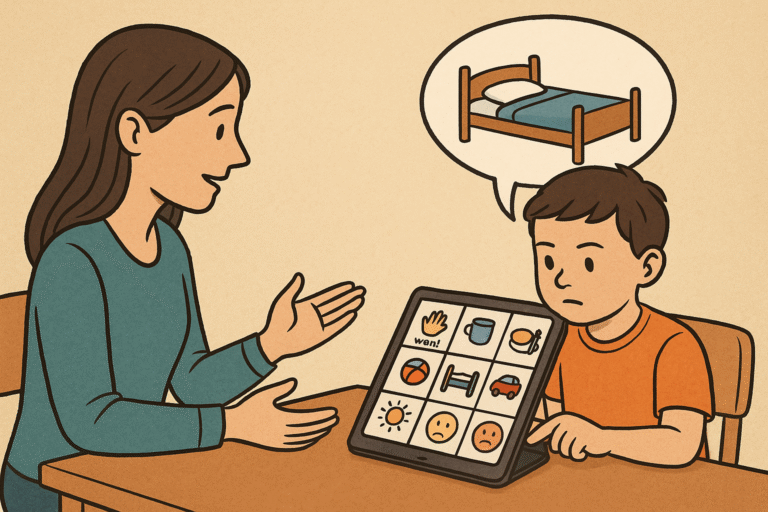Technology and Autism
Technology has revolutionized many aspects of life, but for individuals with autism, it has been particularly transformative.
Digital tools, from apps to assistive devices, are bridging communication gaps, improving social skills, and enhancing learning experiences.

As technology advances, it continues to open new doors for autistic individuals, helping them navigate the world more effectively and independently.
Enhancing Communication for Nonverbal Individuals
One of the biggest challenges faced by individuals with autism is communication. Many autistic individuals are nonverbal or have limited verbal abilities, making it difficult to express their needs and emotions.
Augmentative and Alternative Communication (AAC) devices, such as speech-generating apps and tablets, have revolutionized the way nonverbal individuals communicate.
Apps like Proloquo2Go and TouchChat HD allow users to construct sentences using symbols, helping them articulate thoughts and interact with others. These tools not only provide a voice to the nonverbal but also reduce frustration and improve their quality of life.
Boosting Social Skills and Interaction
Social interaction is another area where technology plays a crucial role in supporting autistic individuals. Virtual reality (VR) and artificial intelligence (AI)-powered social skills training programs offer safe environments where individuals can practice conversations, recognize emotions, and understand social cues.
For example, platforms like Floreo VR provide immersive experiences that help autistic individuals learn social interactions in a controlled setting.
AI-driven chatbots can also assist in modeling appropriate conversation patterns and responses, making socialization less overwhelming.
Personalized Learning and Education
Traditional learning environments may not always cater to the diverse needs of autistic individuals. However, technology has enabled more personalized educational experiences through interactive and adaptive learning platforms.
Apps like Khan Academy Kids and Otsimo offer gamified learning modules that keep students engaged while catering to their unique learning pace.
These tools can help autistic learners develop literacy, math, and cognitive skills in a structured, visually appealing manner that minimizes sensory overload.
Comparison of Educational Apps for Autism
| App Name | Key Features | Suitable For |
|---|---|---|
| Proloquo2Go | Symbol-based communication | Nonverbal individuals |
| Otsimo | Gamified learning & speech therapy | Young children |
| Floreo VR | VR-based social skills training | Social interaction improvement |
| Khan Academy Kids | Interactive educational content | Early learning |
Reducing Sensory Overload
Many individuals with autism experience sensory sensitivities that can make everyday environments overwhelming. Technology has provided various solutions to mitigate these challenges, making it easier to manage sensory processing difficulties.

Noise-canceling headphones, for example, help reduce auditory overload, while apps like Calm Counter assist in self-regulation by guiding users through breathing exercises and coping strategies.
Smart home devices, such as customizable lighting systems, allow autistic individuals to adjust their surroundings to suit their sensory needs.
Supporting Independent Living
As autistic individuals transition into adulthood, technology aids in fostering independence by providing tools that assist in daily tasks, organization, and safety.
Smart assistants like Amazon Alexa or Google Assistant help with reminders, scheduling, and navigation. GPS tracking devices such as AngelSense enhance safety by allowing caregivers to monitor the whereabouts of individuals who may have a tendency to wander.
These tools empower autistic individuals to lead more autonomous lives while ensuring their well-being.
Technology Tools for Independent Living
| Tool | Function | Benefit |
|---|---|---|
| Amazon Alexa | Voice assistant | Helps with scheduling and reminders |
| AngelSense GPS | GPS tracking | Ensures safety and prevents wandering |
| Smart Home Devices | Customizable lighting & automation | Reduces sensory stress |
Teletherapy and Remote Support
Access to therapy and specialized support has been greatly enhanced through teletherapy services. Many autistic individuals benefit from speech, occupational, and behavioral therapy, and digital platforms have made these services more accessible.
Telehealth services like TheraPlatform and Brightline provide virtual therapy sessions, enabling consistent support regardless of location.
These platforms not only benefit individuals but also provide training and resources for parents and caregivers to reinforce learning and progress at home.
Technology for Caregivers and Parents
Caregivers and parents of autistic individuals also benefit from technological advancements. Online resources, mobile applications, and smart monitoring devices help them better support and understand their loved ones.
Websites like Autism Speaks provide valuable information, while apps like Autism Tracker Pro help caregivers monitor behaviors and progress over time.
The Future of Technology in Autism Support
As artificial intelligence, machine learning, and neurotechnology continue to evolve, the potential for technology to further improve the lives of autistic individuals is boundless.
Innovations such as brain-computer interfaces and AI-powered emotion recognition tools may provide even more tailored support, enhancing communication, education, and independence.
The integration of technology into autism support is not just a trend; it’s a game-changer. By embracing digital advancements, society can create a more inclusive world where autistic individuals have the tools they need to thrive.
Final Thoughts
Technology has already made a significant impact in the autism community, providing vital support in communication, education, socialization, and independence.
With continued advancements, digital tools will play an even greater role in fostering inclusivity and enhancing the quality of life for autistic individuals worldwide.
By leveraging technology, we can break barriers and build a future where autism is not a limitation but a different way of experiencing the world.





